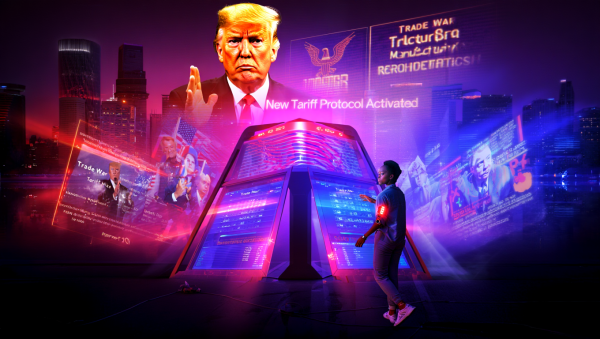
Jul 2, 2025
Let’s cut right to the chase. Trump drops a bombshell tariff announcement—mentioning 30, 40, 50% levels that rattle markets. Countries sweat. Investors panic. Then, in classic Trump form, grace periods appear, rates get delayed, enforcement gets softened. In the end, we’re looking at a 10% slapped on everything—universal, deep, and broad. It doesn’t sound as dramatic, but by the time deals are signed, hundreds of billions land in U.S. coffers.
Remember what Machiavelli said—“Everyone sees what you appear to be, few experience what you really are.” That loud threat? It’s less about breaking knees and more about bending wills. You shout apocalyptic tariffs so the eventual peace treaty feels like victory.
Trump’s tariff statements have always had that swagger. He’s long mastered the spotlight—from pageants to TV to the White House stage. Tariffs aren’t just policy for him—they’re performance art. First, he drops a massive bomb—30, 40, even 50 percent tariffs—markets swoon, countries panic. Then, grace periods roll out, enforcement gets delayed, softening moves come into play until the story resolves at 10 percent. It reads like improvisational theater: shout doom, then deliver “fair” terms, and cue applause.
But it’s not sloppy—it’s calculated. Publicly he threatens a trade apocalypse; privately he sets everyone up to feel relieved. The noise inflates expectations so that the final outcome seems mild and even positive. It’s classic psychological framing—set a high anchor, offer a compromise, claim victory.
Machiavelli put it this way: “Everyone sees what you appear to be, few experience what you really are.” The giant threats? They’re distractions. What really matters is orchestrating outcomes under the guise of concession.
Part 1: It’s Not About the Size, It’s About the Frame
He bombs in with dire-sounding threats, then kindles relief with a “modest” final offer. That 10–15% tariff? It becomes reasonable. Maybe even a win. The Penn-Wharton Budget Model estimates those tariffs could raise $5.2 trillion over the next ten years—before accounting for drag on growth and retaliation (budgetmodel.wharton.upenn.edu).
And check out the Peterson Institute numbers: a 15-point tariff hike could raise $3.9 trillion, but only net $3.2 trillion once pushback kicks in – so your headline becomes “Tariffs net $1.6 trillion”—not dystopian economics.
Estimates say this regime could bring in $5.2 trillion in revenue over the next decade budgetmodel.wharton.upenn.edu. Even accounting for economic drag, the net is still a trillion-plus—money that didn’t magically appear.
He’s not imposing apocalypse. He’s setting the script—expect chaos, get calm. Coupled with nearly $200 million in daily revenue from tariffs (aljazeera.com), it’s theater that funds the audiobook deal, right?
Look at April 2, when Trump announced sweeping reciprocal tariffs—marking the highest surge since the 1930s. Markets tanked that day: the S&P dropped nearly 1.8 percent, Nasdaq 2.6 percent, and markets around the world sold off en.wikipedia.org+1reuters.com+1. Headlines screamed “trade war.”
This approach is shadows over substance. You create fear so the actual outcome seems like relief—even if it’s a disguised tax. And trust me, most countries sign. They’ll take a hit to avoid the disruption. Especially China. A 10–30% tariff? That’s an olive branch in the context of months-long delays and feared quote-unquote Armageddon
Countries feel squeezed but still sign on. Why? They pick the least-worst outcome. A 10–15 percent universal tariff doesn’t wreck trade lanes—in fact, China and others may grudgingly accept it to keep their exporters alive.
The framing works. You inflate expectations with doom, then position the actual tariff as a relief. Deals get done under calm, yet all parties walk away claiming a win.
Part 2: Markets Yawn, Rationalizing the Chaos
Markets often dip on shock—but they recalibrate fast. Tariff news triggers brief selloffs, but then recovery kicks in. Why? Because liquidity remains strong, stimulus stays in the system, and the cycle’s bigger than any one tweet.
Stocks dip. Bonds surge. Oil jittery. And then? It all settles. Inflation stays tame, U.S. jobs remain solid, GDP doesn’t crater. Take the current episode involving Iran and Israel. The U.S. reportedly gave Iran a heads-up before striking; they wanted controlled damage. pi.commoneyweek.com. And Iran responding in kind without disrupting oil lanes. Again, public theatre. Same performance. Same script. Same market response. Nothing shakes the structural setup.
Oil jumped 7 per cent intraday but fell back sharply once traders confirmed the Strait of Hormuz was unaffected and supply remained ample, ft.com. It didn’t spiral the way markets did during the Gulf War—this time, traders judged the cycle, not the headlines.
This isn’t inertia. It’s vector behavior. Algorithms and AI haunt every corner now. The initial shock spikes sentiment. Then it decays. The bigger noise doesn’t move the needle. People might clutch their Pearl Jackets for a news-driven panic, but the deeper currents—liquidity, flow, earnings—are what drive the cycle.
Same logic applies to tariffs. You see the initial drop, followed by a measured bounce. ISM data still showing manufacturing in contraction marketwatch.com, yet stocks rebound. Consumer fears settle. Traders walk it back.
The lesson isn’t that news is meaningless—it’s that cycles and liquidity dominate. In an AI-driven, algorithmic world, buy-the-dip reflexes were coded back in long ago. Noise registers—and fades.
Part 3: The AI Layer and Quiet Power
All this noise is a smokescreen. Today, power moves in algorithms. Decisions based on sentiment analysis, satellite feeds, supply data—all without a human listening to the noise. This is Machiavelli for the digital age: influence achieved by invisible hands behind code—not just barrels or bombs.
Markets aren’t fooled anymore. One tweet might scare them—but not break them. The real war is in our attention, not our trading screens. And AI runs the newsroom, the radar, even the backstage signals. It decides who gets to speak, what’s amplified, how fast. Cued theater? Yes. But bound by code. So the rhetoric doesn’t matter as much as how it triggers, then retracts. And most experts miss it—lost in the echo of the amp, not the drop of the beat.
Part 4: The Psychology of Perceived Winners
This is not instinctual. It’s strategic. You don’t need to bogey every deal. You just need to frame it. Threat. Bounce. Relief. Congratulations, you win—without ever crashing the system.
When you keep expectations low enough, even a 10% tariff or a limited strike feels like a victory. It’s classic mass psychology. People look for patterns. If you set the expectation at disaster, anything less feels like success. That’s why 90% theater yields headlines and applause.
But the punchline is wealth. Tariffs generate revenue. Markets stay afloat. Trade shifts. U.S. partners breathe. China takes one for the team. And everyone’s left believing they got the better end of the deal.
Confucius might’ve said it better: “By three methods we may learn wisdom: reflection, imitation, experience.” The reflection is in watching the script. You mimic the moves. You learn the cycle. Then you evolve.
Part 5: Strategic Patience Over Panic Waves
This stuff won’t end up in bullet-point contracts. The actual flow happens in boardrooms, supply chains, long-term contracts dealing with inflation and logistics. Tariffs are one tool in the geoeconomic toolkit—media bait wrapped in leverage.
Markets shrug because they’ve been here. Iran scares? Been there. Trade threats? Seen it. Trump theatre? Groundhog Day.
Settle in. Don’t react. Watch. Smart players will wait for vector alignment—that moment when sentiment shifts, when real delivery arrives. Tariffs hit, markets shrug, trade patterns reroute. That’s the move—the one beneath the noise.
Final Word: Smarter Than the Theater
Tariffs aren’t dumb taxes. They’re staged moves meant to be noticed, then forgotten. It’s the difference between weapon and warning.
Machiavelli said, “The vulgar crowd always is taken by appearances…” Here, the crowd sees noise. We see vectors. We see framing, leverage, hidden incentives.
The question isn’t whether the tariffs are big—it’s whether they move the system. That’s strategy. All the rest? Just background noise.
Leaving a Mark: Impactful Articles












